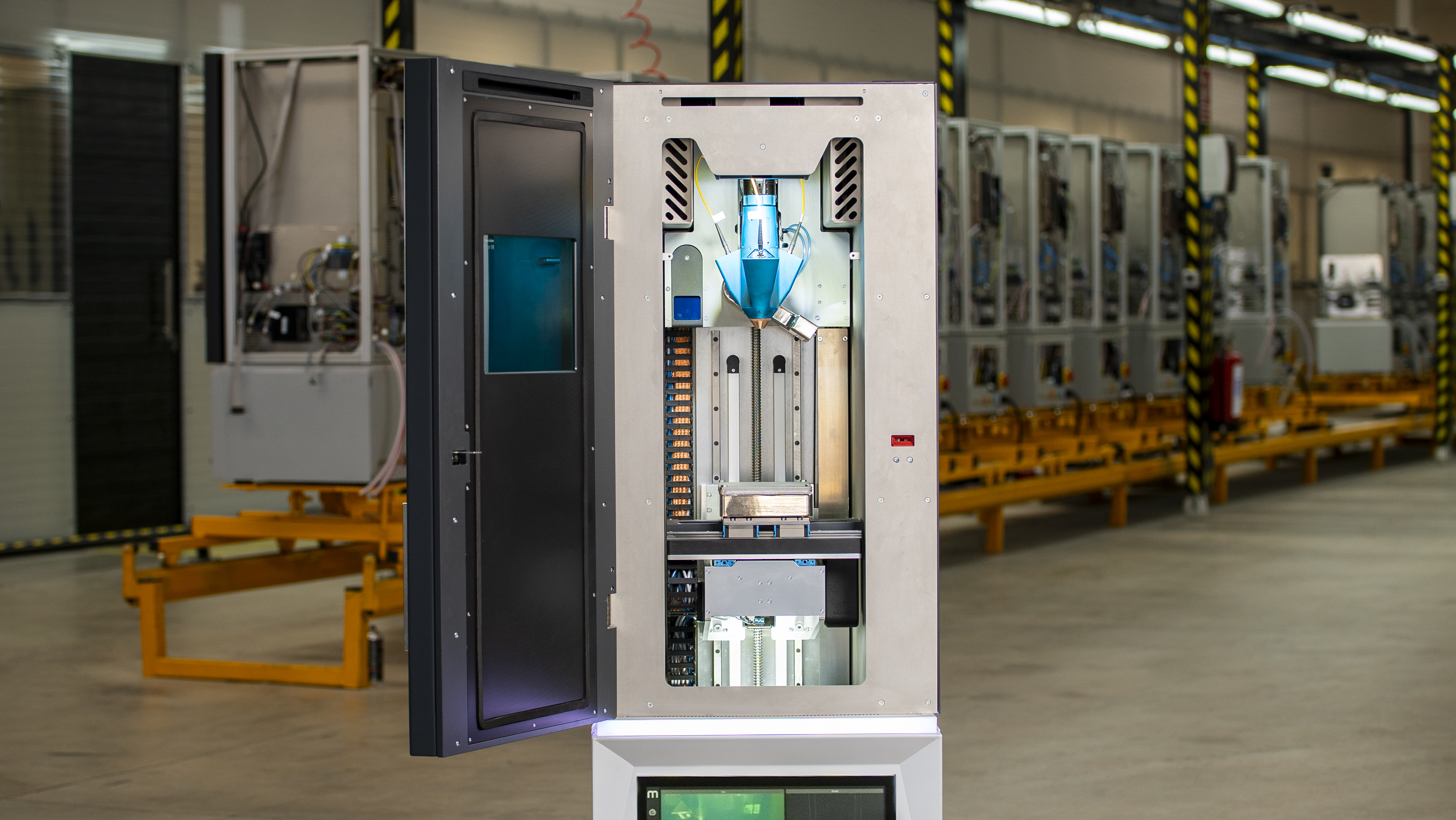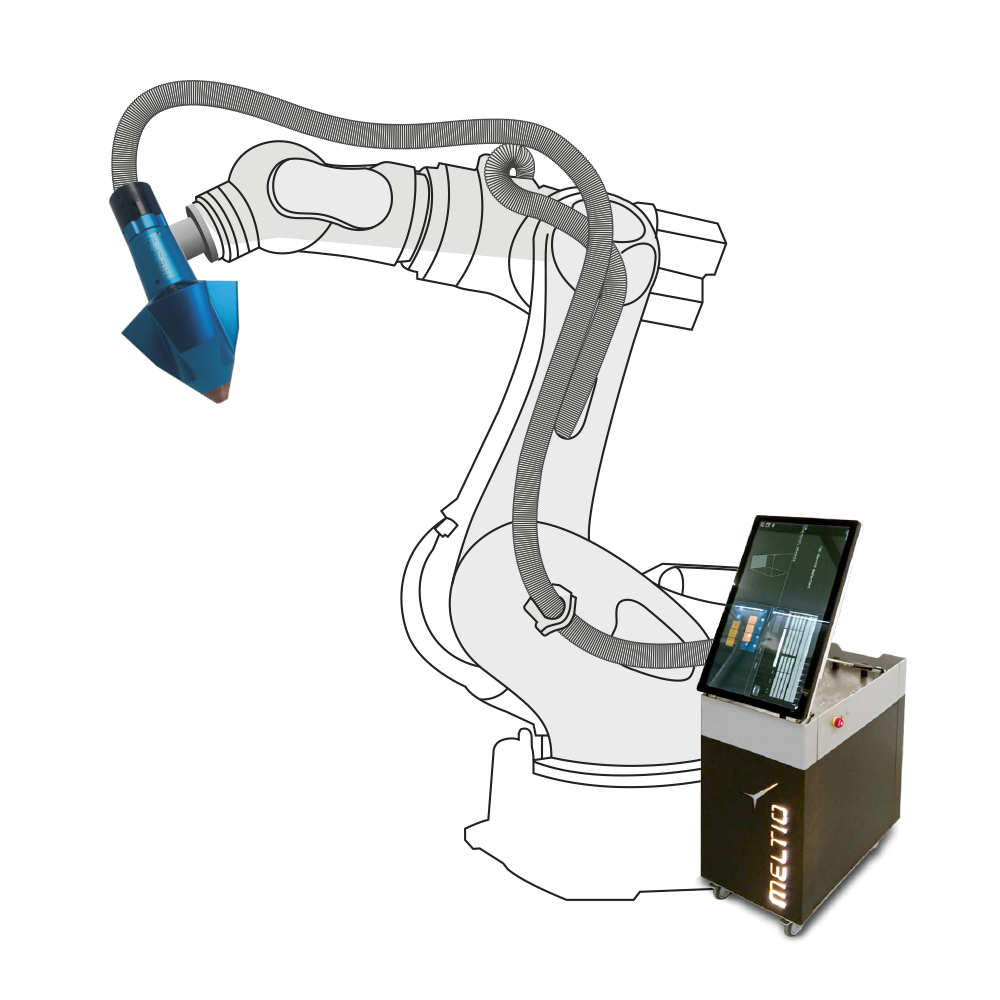Founded in May 2019, metal 3D printing company Meltio began through a partnership between Spanish 3D printer and scanning equipment manufacturer, Sicnova, and Las Vegas-based Additec, a company, devised to solve the barriers to manufacturing large metal components.
Although Meltio is only a year and a half old, its technology has been in development for far longer, first emerging under Additec in 2015. Additec now functions as Meltio’s research and development (R&D) center, while Sicnovia’s base in Linares operates as the production facility for the firm’s products.
“Meltio wouldn’t have been possible without all of the groundwork done by Additec and Sicnova,” said Dr. Yash Bandari, product manager in Meltio’s Additive Manufacturing Group. “Meltio had its first launch at Formnext last year with a super nice exhibit and had a great reception.”

Meltio’s LMD-WP technology
Meltio’s technology is a variant of Laser Metal Deposition (LMD), called LMD-WP (Wire Powder), which falls under the branch of Directed Energy Deposition (DED) processes. LMD refers to a welding process in which a material is introduced into a melt pool, created by a high-power laser. A filler material, typically powder, is injected through a conical ring nozzle around the laser beam to create a weld bead, which then coats the underlying metal.
Meltio’s LMD-WP process works in much the same way; however, instead of having one laser beam that enters through the center of the deposition head, the firm uses multiple fiber-coupled diode laser sources that are distributed evenly around the central axis of the head.
“This frees up the central path for solid filler material and allows for the unidirectional processing of common MIG welding wires,” explains Bandari. “Around the wire orifice, our deposition head also features multi off-axis powder nozzles. This way, no functionality is lost compared to conventional laser cladding heads. In addition, it is also possible to deposit wire and powder at the same time to create a new alloy of the two components.”
According to Bandari, the ability to print using metal wire and metal powder independently or simultaneously without a nozzle change is a first-of-a-kind feature within the additive manufacturing sector. Meltio’s patented laser head leverages the advantages of both wire DED and powder DED inside a single machine, with the technology’s high laser power, multiple wire feeders, and hot wire feed options facilitating high material deposition rates while retaining the precision and resolution of a laser process. Other functions, such as metal coating, texturing, polishing, and cutting, can also be carried out without external equipment.
Utilizing hot wire within Meltio’s machines helps increase the deposition rate while reducing the process’s heat-input. This enhances the microstructure and, in turn, improves the dimensional accuracy of the deposited part.

Meltio’s M450 metal printer and engine modules
Meltio’s leading product portfolio includes its M450 small-footprint industrial metal 3D printer, which Bandari says is ideal for office and laboratory environments. Despite its compact size, the printer features a 150x200x450 mm3 build envelope and possesses a controlled atmosphere to produce parts containing reactive metals. A basic version of the M450, with a low laser power of 600W, is priced at $98,000.
Part of the firm’s portfolio is the Meltio Engine, which can be retrofitted to CNC machines, robots, and gantry systems to enable the 3D printing of full density metal parts. Integrating the Meltio Engine enables the production of large components with complex geometries in multiple axes and “hybrid manufacturing.” A basic version of the Meltio Engine module with 600W laser power is also priced at $98,000.
Any material available in the form of a welding wire or powder can be used with Meltio’s LMD-WP technology, with steel, nickel, titanium, aluminum, and copper alloys having all been successfully demonstrated so far. The end products have subsequently been used within the aerospace, automotive, oil and gas, and medical sectors for various applications.
“Process stability was the most important aspect for the development of our printers,” continued Bandari. “As wire-based coaxial deposition is not as common as powder LMD, we developed our process control structure that not only adjusts the processing parameters on the fly depending on the height characteristics of the previously deposited layer, but also measure the height of the individual layers, and adjusts nozzle-to-part distance automatically.”
Part density of 99.99% can be achieved through Meltio’s LMD-WP process, mainly dependent on its customized process parameters and tool-path strategies.
“We spent a lot of time fine-tuning the process parameters and developing novel tool-path strategies that can be applicable for DED processes,” Bandari added. “Using these parameters and subsequent post-processing processes, we could achieve properties closer to wrought properties for most of the typical alloys. Therefore, applications like aerospace, automobile, and oil and gas, would benefit from this R&D work.”

Why use wire and powder simultaneously?
Powder and wire can be used at the same time to fabricate Metal Matrix Composites (MMCs), a class of materials in which one or more materials are added to metal to achieve specific property enhancements. Traditionally, MMCs are manufactured through powder metallurgy; however, this process can be expensive and time-consuming.
To bypass this, MMCs can be constructed through Meltio’s LMD-WP process at a lower cost and with shorter lead times. Meltio’s approach will also enhance the mechanical properties of the MMCs, Bandari said.
One example of where the process has been effective in this way is the addition of Titanium Carbide (TiC) as an alloying element in the form of powder to a melt pool of Ti64. This titanium alloy is well-known for its low density, high strength, and excellent corrosion resistance. Through the LMD-WP process, the addition of TiC significantly improves the wear resistance of Ti64, which subsequently becomes an MMC.

Meltio’s ongoing and upcoming projects
At present, Meltio is involved in several aerospace projects. Under a Small Business Innovation Research (SBIR) grant, the firm has developed a laser-wire additive manufacturing technology to enable the joining and repair of metal structures in space.
“In this process, we already demonstrated the use of our technology to perform metal additive manufacture in space,” explained Bandari. “Further, we are fabricating a custom Express Rack mounted Direct Metal Deposition printer for space applications that will allow rapid and on-demand printing of metal parts in the resource-constrained environment of the ISS.”
Currently, the firm produces lasers that can deliver a maximum laser power of 6kW. In the future, Meltio will investigate the production of lasers with power output as high as 10kW to 15kW at affordable costs through engaging with several research organizations and universities performing cutting edge research in this area.
Aside from space-related additive manufacturing projects, Meltio is also working with several customers within the aerospace, automotive, nuclear, oil and gas, and jewelry sectors, looking to utilize its multi-metal 3D printing technology to reduce cost and lead times in the manufacturing of their products.
Subscribe to the 3D Printing Industry newsletter for the latest news in additive manufacturing. You can also stay connected by following us on Twitter and liking us on Facebook.
Be sure to subscribe to the Another Dimension podcast on your chosen podcast player to make sure you never miss an episode.
Looking for a career in additive manufacturing? Visit 3D Printing Jobs for a selection of roles in the industry.
Featured image shows Meltio’s M450 small-footprint industrial metal 3D printer. Photo via Meltio.


